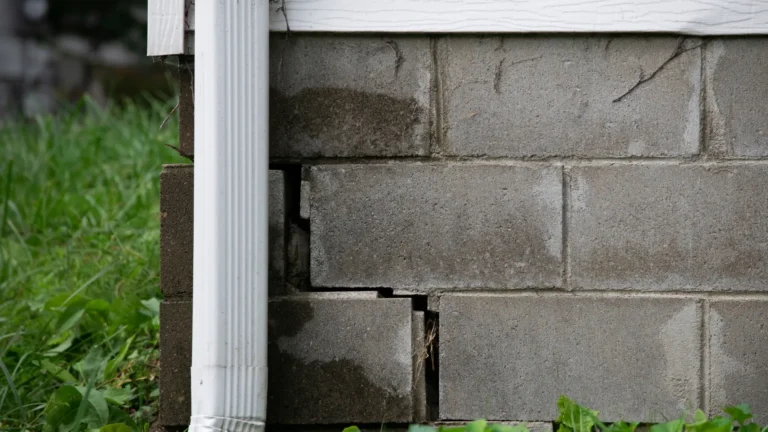A strong foundation is the backbone of any safe and durable home. Over time, foundations can be damaged by soil movement, moisture changes, or natural settling, which can cause cracks, uneven floors, or even structural instability. If you see signs of foundation problems, it’s crucial to address them quickly with the right repair methods to protect your home’s integrity and value. In this article, we’ll go over How Do You Fix a Damaged Foundation, covering common types of foundation issues, practical repair methods, and real world examples. Whether your home has a slab or pier and beam foundation, understanding the foundation repair methods will help you make informed decisions and get lasting results.
Signs Your Foundation Needs Repair
Before we get into repair solutions, it’s important to know when your foundation may be compromised. Common warning signs include:
- Cracks in the wall, especially near doors, windows, or corners
- Uneven or sloping floors
- Doors and windows that stick or won’t close properly
- Gaps between walls and ceiling, or floors
- Bowing or leaning basement walls
- Water intrusion or dampness in the basement or crawl space
If you see any of these symptoms it’s wise to consult a foundation specialist for an inspection.
Common Foundation Repair Methods
The best foundation repair method depends on the type of foundation, the severity of damage and soil conditions. Here are some of the most effective and widely used techniques:
1. Slab Foundation Repair
Concrete slab foundations are common in many homes and can develop cracks or uneven settling over time. Slab foundation repair focuses on stabilizing and leveling the concrete slab.
Slab Jacking (Mudjacking or Polyurethane Foam Jacking):
This method involves injecting a grout mixture or expanding polyurethane foam beneath the sunken slab to lift and level it. For example polyurethane foam jacking is a quick and minimally invasive technique that fills voids under the slab and raises it back to its original position within minutes. This is cost effective and suitable for repairing concrete foundation cracks and uneven slabs.
Concrete Crack Repair:
For minor cracks epoxy or polyurethane injections can seal cracks and restore structural integrity, prevent water intrusion and further damage.
2. Pier and Beam Foundation Repair
Homes built on pier and beam foundations require different repair strategies because of their elevated structure.
Steel or Concrete Piers:
Steel piers are driven deep into stable soil beneath the foundation and then hydraulically jacked to lift and stabilize the home. Concrete piers do the same but are poured into drilled holes. These piers support the foundation and prevent further settling.
Underpinning:
Underpinning is extending the foundation depth or width to distribute the load better. This is often done in conjunction with pier installation to stabilize older or shifting foundations.
3. Foundation Leveling
Foundation leveling corrects uneven settling by raising the foundation to its original position. Techniques include:
- Hydraulic Piering: Using hydraulic jacks to lift the foundation supported by steel or helical piers.
- Slab Jacking: As described above, raising sunken slabs by injecting material underneath.
Foundation leveling not only restores structural stability but also improves the home’s appearance and functionality.
4. Structural Foundation Repairs
In cases of severe damage, structural repairs may be necessary, including:
- Installing helical tieback anchors to stabilize bowed basement walls.
- Adding shepherd’s crook supports beneath foundations to prevent further settling.
- Repairing or replacing damaged beams or footings.
These repairs often require professional engineering assessments and specialized equipment.
Real-World Example: Fixing a Sunken Slab Foundation
A homeowner in Houston noticed cracks in their concrete floors and doors that wouldn’t close properly. After inspection, the foundation specialist recommended polyurethane foam jacking to lift the sunken slab. The technician drilled small holes in the slab and injected expanding foam beneath it. Within minutes, the slab was leveled, cracks sealed, and the home stabilized. This quick and minimally disruptive repair restored the foundation without full replacement, saving time and money.
Practical Tips for Foundation Repair
- Early Detection: Address foundation issues as soon as you notice symptoms to prevent costly damage.
- Professional Assessment: Always consult a licensed foundation repair specialist for accurate diagnosis and recommendations.
- Choose the Right Method: Match the repair method to your foundation type and soil conditions for lasting results.
- Regular Maintenance: Control moisture around the home by ensuring proper drainage and gutter function to reduce foundation stress.
- Get Multiple Quotes: Compare repair options and costs from several contractors to find the best solution for your budget.
